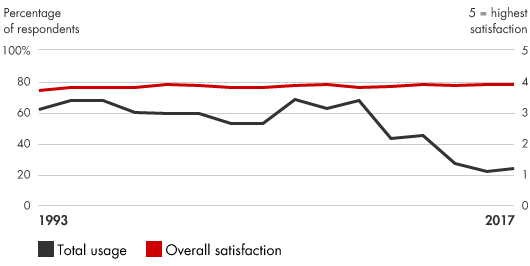Management Tools
Strategic Alliances are agreements among firms in which each commits resources to achieve a common set of objectives. Companies may form Strategic Alliances with a wide variety of players: customers, suppliers, competitors, universities or divisions of government. Through Strategic Alliances, companies can improve competitive positioning, gain entry to new markets, supplement critical skills and share the risk or cost of major development projects.
Usage and satisfaction among survey respondents

How Strategic Alliances work:
To form a Strategic Alliance, companies should:
- Define their business vision and strategy in order to understand how an alliance fits their objectives
- Evaluate and select potential partners based on the level of synergy and the ability of the firms to work together
- Develop a working relationship and mutual recognition of opportunities with the prospective partner
- Negotiate and implement a formal agreement that includes systems to monitor performance
| RELATED TOPICS | HOW BAIN CAN HELP |
|---|---|
|
Companies use Strategic Alliances to:
- Reduce costs through economies of scale or increased knowledge
- Increase access to new technology
- Inhibit competitors
- Enter new markets
- Reduce cycle time
- Improve research and development efforts
- Improve quality
Selected references
Armstrong, Arthur G., and John Hagel, III. Net Gain: Expanding Markets Through Virtual Communities. Harvard Business School Press, March 1997.
de Man, Ard-Pieter. Alliances: An Executive Guide to Designing Successful Strategic Partnerships. John Wiley & Sons, 2014.
Doz, Yves L., and Gary Hamel. Alliance Advantage. Harvard Business School Press, 1998.
Dyer, Jeffrey H., Prashant Kale, and Harbir Singh. “How to Make Strategic Alliances Work.” MIT Sloan Management Review, Summer 2001, pp. 37–43.
Dyer, Jeffrey H., Prashant Kale, and Harbir Singh. “When to Ally and When to Acquire.” Harvard Business Review, July 2004, pp. 108–115.
Echavarria, Martin. Enabling Collaboration: Achieving Success Through Strategic Alliances and Partnerships. LID Publishing, 2016.
Kanter, Rosabeth Moss. “Collaborative Advantage: The Art of Alliances.” Harvard Business Review, July/August 1994, pp. 96–108.
Kaplan, Robert S., David P. Norton, and Bjarne Rugelsjoen. “Managing Alliances with the Balanced Scorecard.” Harvard Business Review, January 2010, pp. 114–120.
Lewis, Jordan D. Trusted Partners: How Companies Build Mutual Trust and Win Together. Free Press, March 2000.
Rigby, Darrell K., and Robin W. T. Buchanan. “Putting More Strategy into Strategic Alliances.” Directors and Boards, Winter 1994, pp. 14–19.
Rigby, Darrell K., and Chris Zook. “Open-Market Innovation.” Harvard Business Review, October 2002, pp. 80–89.
Shenkar, Oded, and Jeffrey J. Reuer, eds. Handbook of Strategic Alliances. Sage Publications, 2005.
Slowinski, Gene, and Matthew W. Sagal. The Strongest Link: Forging a Profitable and Enduring Corporate Alliance. AMACOM, 2003.
Steinhilber, Steve. Strategic Alliances: Three Ways to Make Them Work. Harvard Business School Press, 2008.